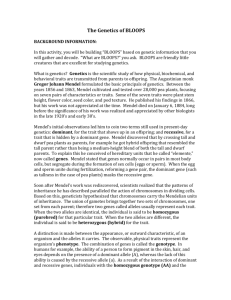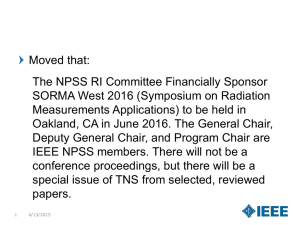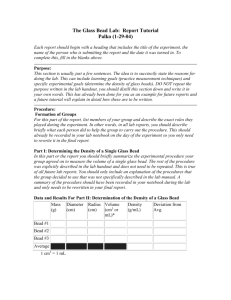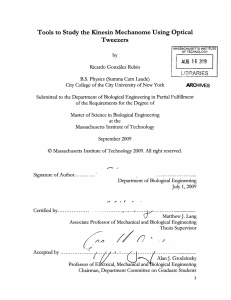Homework 9
advertisement
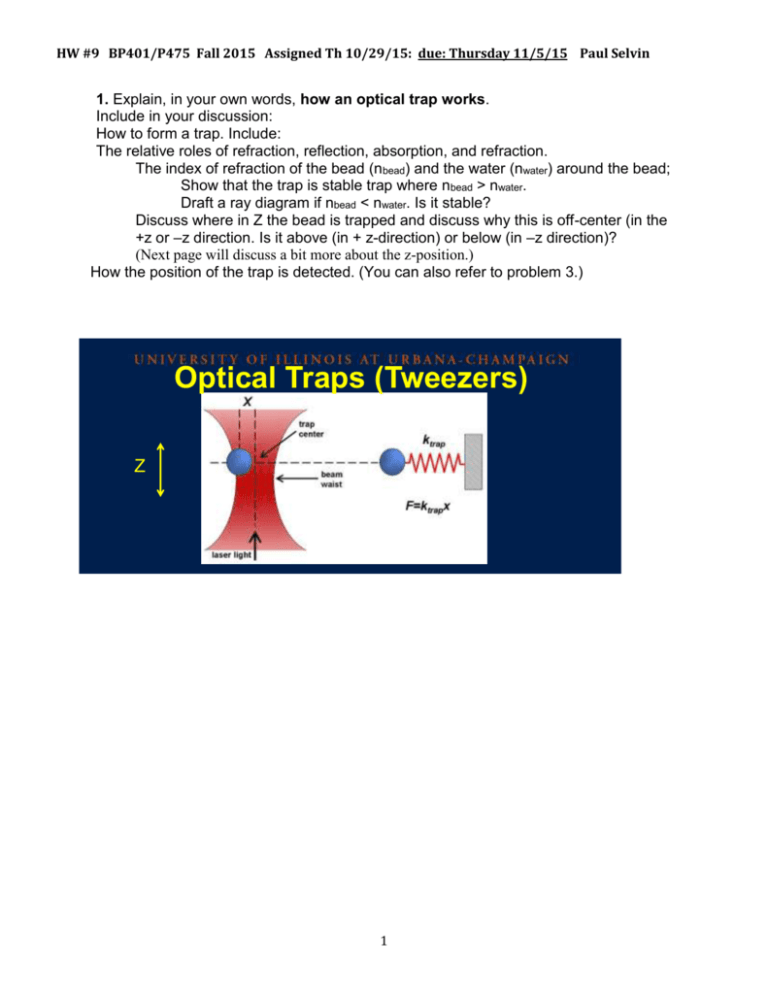
HW #9 BP401/P475 Fall 2015 Assigned Th 10/29/15: due: Thursday 11/5/15 Paul Selvin 1. Explain, in your own words, how an optical trap works. Include in your discussion: How to form a trap. Include: The relative roles of refraction, reflection, absorption, and refraction. The index of refraction of the bead (nbead) and the water (nwater) around the bead; Show that the trap is stable trap where nbead > nwater. Draft a ray diagram if nbead < nwater. Is it stable? Discuss where in Z the bead is trapped and discuss why this is off-center (in the +z or –z direction. Is it above (in + z-direction) or below (in –z direction)? (Next page will discuss a bit more about the z-position.) How the position of the trap is detected. (You can also refer to problem 3.) Optical Traps (Tweezers) Z Dielectric objects are attracted to the center (x-y) of the beam where light is brightest. (Slight deviation in z-direction due to reflection.) Depends on gradient of beam, index of refraction of bead vs. water. Vary ktrap with laser intensity such that ktrap ≈ kbio (k ≈ 0.1pN/nm) ~ to stiffness of motor. Can measure pN forces and (sub-) nm steps! http://en.wikipedia.org/wiki/Optical_tweezers 1 HW #9 BP401/P475 Fall 2015 Assigned Th 10/29/15: due: Thursday 11/5/15 Paul Selvin 2. Lateral Trapping. Explain why there is a sideway force (in the x,y plane) represented by the light blue arrow, below. Does it have a z-component? Is it along +z or –z, or zero? Why? Lateral (x-y) gradient force (leads to trapping in x-y) (Snell’s law twice: two surfaces) Bright ray Dim ray Z ßà X Object feels a force toward brighter light 2 HW #9 BP401/P475 Fall 2015 Assigned Th 10/29/15: due: Thursday 11/5/15 Paul Selvin 3. Z-Direction Laser Trapping. Recall the lecture (see below) the z position of the bead. Axial (z-axis) gradient force: leads to trapping in z How so? ΔP Pi Focused light Pf Pi Z ßà Object feels a force toward focus Force ~ gradient intensity In lectures 16 and 17 notes, a ray diagram was used to argue that when a dielectric bead was below the focus of a laser beam there was a net force pushing up on the bead towards the focus. Now let’s make a similar picture for the case where the center of the bead is above the laser focus and use geometric optics to find the direction of the force exerted on the bead. (For the time being, assume that there is no scattering or absorption by the bead.) a) Attached to this problem set (next page) is a picture of a bead, which is being trapped by laser light. The dashed lines show the direction the rays would travel if the bead were not refracting the rays (the intersection of the dashed lines show that the focus is below the center of the bead.) Interface perpendicular’s are drawn in for your convenience as well. On the picture provided, complete the ray drawing and turn this in with your homework assignment (make sure to put your name on the picture as well.) What direction is the force that the trap exerts on the bead? b) In the absence of any scattering or absorption from the bead, where is the bead trapped along the Z-direction? Why? c) If the bead scatters a significant amount of laser light will the bead be trapped above or below the focus? Why? 3 HW #9 BP401/P475 Fall 2015 Assigned Th 10/29/15: due: Thursday 11/5/15 Paul Selvin Problem #3. Print out page and turn in, with your name on it. Light +Z 4 HW #9 BP401/P475 Fall 2015 Assigned Th 10/29/15: due: Thursday 11/5/15 Paul Selvin 4. Odd Shaped Bead An unusually shaped bead is placed in an optical trap. Parallel light is incident along the vertical direction. The intensity of light is higher on right than the left. Perpendicular lines to the bottom surfaces have been drawn in (dotted lines) for your convenience. What direction is the force on the bead in the horizontal direction? Draw a ray diagram of the light and explain how this leads to your conclusion. (Print out current page out and turn it in with your assignment.) Increasing intensity n>1 n=1 5 HW #9 BP401/P475 Fall 2015 Assigned Th 10/29/15: due: Thursday 11/5/15 Paul Selvin 5. This is a reminder for you for the next question. Let’s say you have parallel light coming into a lens (from the left), what will happen to the light to the right-hand side of the lens? Will it be focused? If so, where, and how small of a spot? According to geometrical optics, the size of the spot will be what? According to a full-blown theory (taking into account diffraction) what size will the point be? (You do not need to calculate this—it’s quite difficult. You should know this, but if you don’t look it up.) How you get parallel light? Recall Len’s Maker’s Equation Put object at the focal length of lens. Then image is at infinity. 6 HW #9 BP401/P475 Fall 2015 Assigned Th 10/29/15: due: Thursday 11/5/15 Paul Selvin 6. Detection of an Optical Trap. Show that when a spherical is moved off-center (such as the red figure), it will tend to move the light as shown. How can an optical trap then be used to measure displacement of a bead? deflected. This deflection directly measured using a sensitive photodiode detector. 7 can be position- HW #9 BP401/P475 Fall 2015 Assigned Th 10/29/15: due: Thursday 11/5/15 Paul Selvin 7. Step size, Stall force and how to measure it. If the bead is pulled to the side by a molecular motor (a DNA or RNA polymerase, or translating motor such as kinesin— see below), will the force of the optical trap on the bead tend to be less, stay the same, or increase? How can you measure the “stall” force, i.e., the force at which the motor will stall? (Note that the stall force is measured in some number of picoNewtons—how do you find the value of the stall force?) If the force varies, what will the step-size of the motor look like? How can you make sure that the force is constant, and therefore give the same step size? 8 HW #9 BP401/P475 Fall 2015 Assigned Th 10/29/15: due: Thursday 11/5/15 Paul Selvin 8. A Biased Step (Recall your Boltzmann factor!) A microtubule has a polarity (directionality), which defines forward and backwards for kinesin walking. You can think of the kinesin having little feet, with a directionality like our feet have. It always binds such that it’s toes are pointing towards the plus direction of the microtubule. When it gets its “gas” (i.e. ATP), it goes forward. However, it doesn’t always go forward (see below). Occasionally, it takes a backward step. It’s a “bias” towards stepping forward. The kinesin uses some of the energy from splitting ATP to direct its motion forward. A backwards step The biased step can be viewed as a two-state system with the kinesin having an energy of Ef for a forward step and an energy Eb for a backward step. If there is a difference in energy between the forward direction versus the backward direction of (i.e. Eb - Ef = ), then the motor will be more likely to move in one direction versus the other. (See the diagram.) Pre-Step State Kinesin Head Eb Ef Backward Step Forward Step 9 HW #9 BP401/P475 Fall 2015 Assigned Th 10/29/15: due: Thursday 11/5/15 Paul Selvin a) What is the ratio of the probability of a forward step to that of a backward step in terms of Ef, Eb and kBT? b) One can set Ef to be zero so that = Eb (the important thing is the difference in energy and not their absolute values). What is the probablility of a forward step in terms of and kBT? (Hint: write down the partition function first and then find the probablility). What is the probability of a backward step (Pb) in terms of Pf (the probability of a forward step)? c) We shall define the net work of the kinesin head to be the work of a forward step (W f) times the probability of a forward step (Pf) minus the work for a backward step (W b) times the probability of a backward step (Pb). In other words, Net Work = W N = Pf * Wf - Pb * W b. There is no difference in work between a forward and a backward step, W f = W b = Fx, since work depends on a force times the change in position, which is the same for both forward and backward motion. Write the Net Work in terms of only Pf and Fx. d) What is Fx in terms of the energy from splitting ATP (EATP) and , the energy required to bias the step forward? Assume the process is 100% efficienct so that all the energy from splitting ATP goes into mechincal work and biasing the walk. e) Write W N as a function of in terms of EATP, , kBT, Pf, and then substitute what you got for Pf in part (b). At this point, W N should be in terms of only EATP, , and kBT. f) We want to find the value of which maximizes the net work, such that the energy from ATP is used most efficiently. Using the equation in part (e), derive an expression (equation) for maximizing W N. There is not a simple analytical solution to this new equation. However you can determine the optimal value of in units of kBT by showing it graphically. g) Using the value of you found in part f, what is the probability of a forward and a backward step of a kinesin head? (Experimentally, kinesin steps forward with very high probability.) h) In words, what is the probability of a forward step and the net work if = 0? If = EATP? Can you explain in words why the maximum net work isn’t = EATP/2? 10




